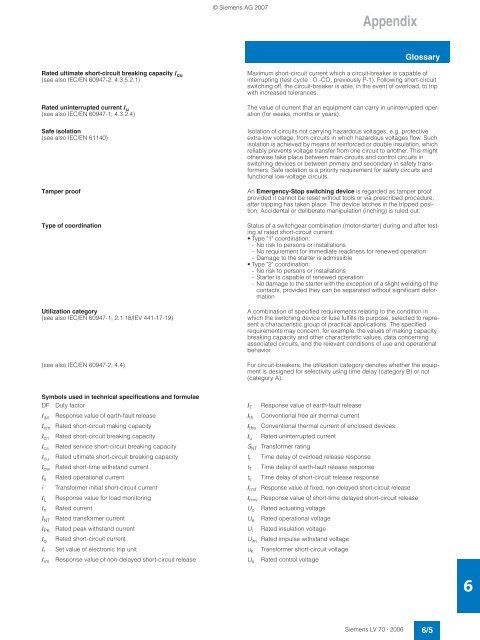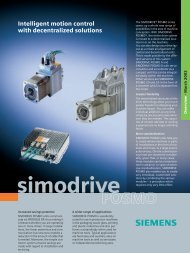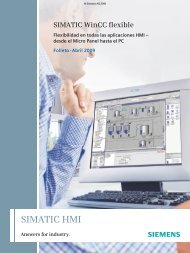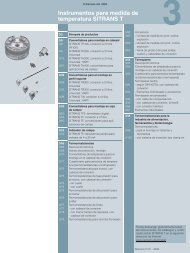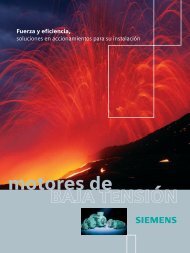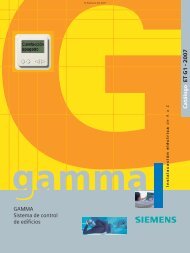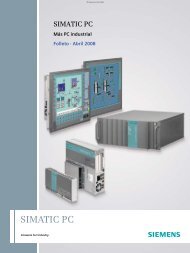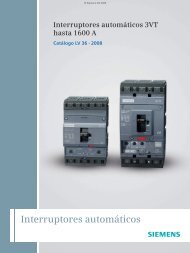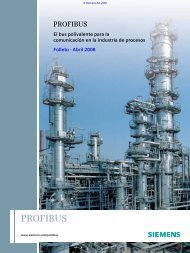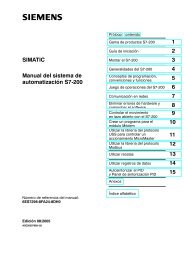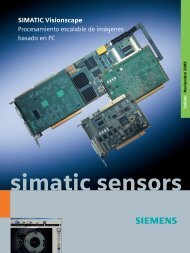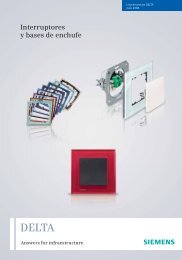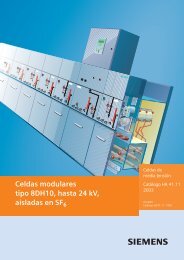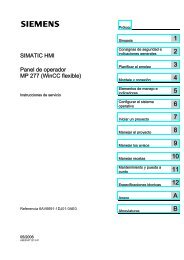Create successful ePaper yourself
Turn your PDF publications into a flip-book with our unique Google optimized e-Paper software.
© Siemens AG 2007<br />
Appendix<br />
Glossary<br />
Rated ultimate short-circuit breaking capacity I cu<br />
(see also IEC/EN 60947-2; 4.3.5.2.1)<br />
Rated uninterrupted current I u<br />
(see also IEC/EN 60947-1; 4.3.2.4)<br />
Safe isolation<br />
(see also IEC/EN 611<strong>40</strong>)<br />
Tamper proof<br />
Type of coordination<br />
Utilization category<br />
(see also IEC/EN 60947-1; 2.1.18/IEV 441-17-19)<br />
(see also IEC/EN 60947-2; 4.4)<br />
Maximum short-circuit current which a circuit-breaker is capable of<br />
interrupting (test cycle : O.-CO, previously P-1). Following short-circuit<br />
switching off, the circuit-breaker is able, in the event of overload, to trip<br />
with increased tolerances.<br />
The value of current that an equipment can carry in uninterrupted operation<br />
(for weeks, months or years).<br />
Isolation of circuits not carrying hazardous voltages, e.g. protective<br />
extra-low voltage, from circuits in which hazardous voltages flow. Such<br />
isolation is achieved by means of reinforced or double insulation, which<br />
reliably prevents voltage transfer from one circuit to another. This might<br />
otherwise take place between main circuits and control circuits in<br />
switching devices or between primary and secondary in safety transformers.<br />
Safe isolation is a priority requirement for safety circuits and<br />
functional low-voltage circuits.<br />
An Emergency-Stop switching device is regarded as tamper proof<br />
provided it cannot be reset without tools or via prescribed procedure,<br />
after tripping has taken place. The device latches in the tripped position.<br />
Accidental or deliberate manipulation (inching) is ruled out.<br />
Status of a switchgear combination (motor-starter) during and after testing<br />
at rated short-circuit current:<br />
• Type "1" coordination:<br />
- No risk to persons or installations<br />
- No requirement for immediate readiness for renewed operation<br />
- Damage to the starter is admissible<br />
• Type "2" coordination:<br />
- No risk to persons or installations<br />
- Starter is capable of renewed operation<br />
- No damage to the starter with the exception of a slight welding of the<br />
contacts, provided they can be separated without significant deformation<br />
A combination of specified requirements relating to the condition in<br />
which the switching device or fuse fulfills its purpose, selected to represent<br />
a characteristic group of practical applications. The specified<br />
requirements may concern, for example, the values of making capacity,<br />
breaking capacity and other characteristic values, data concerning<br />
associated circuits, and the relevant conditions of use and operational<br />
behavior.<br />
For circuit-breakers, the utilization category denotes whether the equipment<br />
is designed for selectivity using time delay (category B) or not<br />
(category A).<br />
Symbols used in technical specifications and formulae<br />
DF Duty factor I T Response value of earth-fault release<br />
I ∆n Response value of earth-fault release I th Conventional free air thermal current<br />
I cm Rated short-circuit making capacity I the Conventional thermal current of enclosed devices<br />
I cn Rated short-circuit breaking capacity I u Rated uninterrupted current<br />
I cs Rated service short-circuit breaking capacity S NT Transformer rating<br />
I cu Rated ultimate short-circuit breaking capacity t r Time delay of overload release response<br />
I cw Rated short-time withstand current t T Time delay of earth-fault release response<br />
I e Rated operational current t v Time delay of short-circuit release response<br />
i Transformer initial short-circuit current I rmf Response value of fixed, non-delayed short-circuit release<br />
I L Response value for load monitoring I rmv Response value of short-time delayed short-circuit release<br />
I n Rated current U c Rated actuating voltage<br />
I NT Rated transformer current U e Rated operational voltage<br />
I PK Rated peak withstand current U i Rated insulation voltage<br />
I q Rated short-circuit current U im Rated impulse withstand voltage<br />
I r Set value of electronic trip unit u k Transformer short-circuit voltage<br />
I rm Response value of non-delayed short-circuit release U s Rated control voltage<br />
6<br />
Siemens LV 70 · 2006<br />
6/5


